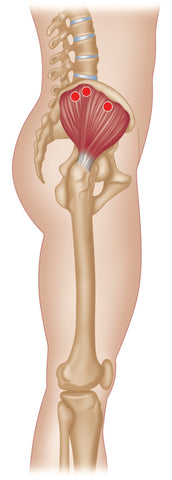Trigger Point Therapy - Relationship of the Gluteus Muscles to Ankle Sprains
Treating Ankle Pain - Stuart Hinds
Did you know that the ankle is the most frequently injured joint, both in athletics and in daily life?
Ankle sprains are the most common athletic injury, and 70–85% of these are inversion-type sprains.
It has been reported that 10–30% of people with acute inversion-type sprains develop chronic mechanical instabilities as well as functional deficits, and approximately 80% of ankle sprains recur.
According to the UK National Health Service (NHS), ankle sprain injuries account for around 1–1.5 million visits to accident and emergency (A&E) departments in the UK each year; and it is estimated that every day over 27,000 people in the USA sprain an ankle.

The ankle joint, showing the lateral ligaments
Stability Compensatory Mechanisms
Ongoing recurrent ankle sprains will, over time, lead to chronic ankle instability issues that will then cause kinetic chain dysfunctions.
These abnormalities will have a knock-on effect on the homeostasis of the whole body, as the proprioceptive neural senses will now be reduced, and the stability compensatory mechanisms will be altered.
The ankle is a very complex joint comprising the talus, tibia, and fibula bones. The lateral ligaments of the ankle are the most susceptible to injury, and it is estimated that at heel-strike, up to five times the body’s weight is loaded onto this joint.
The anterior talofibular ligament (ATFL) is generally the most commonly injured, followed by the calcaneofibular ligament (CFL).
Friel et al., in 2006, conducted a study about ipsilateral hip abductor weakness after an inversion ankle sprain; their results showed that hip abduction and plantar flexion were significantly weaker on the involved side. They concluded that unilateral ankle sprains led to weaker hip abduction (Gmed), and suggested exercises to strengthen the hip abductors when developing rehabilitation protocols for ankle inversion sprains.
The influence of a previous ankle sprain in relation to the firing order and timing of the posterior trunk and leg muscles during the hip extension firing test was investigated by Bullock-Saxton et al. in 1994.
Those authors found a significant difference in the onset of the Gmax activity (delayed onset) in the group with previous ankle sprains compared with the control group.

GMed - Common Trigger Point sites. Trigger Points make the host muscle shorter and weaker and need to be considered when dealing with ankle sprains.
Dynamic Postural Control
In 2010 Leavey et al. reported the results of a study of the comparative effects of balance and strength programs, and a combination of the two, on dynamic postural control.
The authors proposed using two types of strategies for maintaining dynamic postural control, specifically a hip strategy and an ankle strategy.
For the ankle strategy they suggested utilizing the peroneal muscles to maintain balance, while for the hip strategy the Gmed muscle was recommended for correcting balance and posture.
They point out that an individual does not usually strengthen the Gmed muscle when attempting to increase dynamic postural control following a lateral ankle sprain.
Understanding and Treating the Vital Glutes
In most rehabilitation protocols for an inversion sprain, ankle strength training and proprioception training are typically encouraged, as these are used to regain losses in balance that may have occurred.
It was also suggested that the weakened Gmed may cause defective dynamic postural control to worsen, leading to the biomechanics of the entire lower extremity becoming altered; this in turn potentially results in faulty movements, making individuals prone to future ankle injuries.
Finally, it's also worth noting that Schmitz et al., in 2002, demonstrated through an EMG study that there was an increase in Gmed activity during sudden ankle inversion in healthy subjects as well as in those with functionally unstable ankles.
Find a Trigger Point Professional in your area
Articles About Ankle Pain and Stiffness
Dry Needling for Trigger Points
Certify as a Trigger Point Therapist
NAT Online Trigger Point Courses:
This trigger point therapy blog is intended to be used for information purposes only and is not intended to be used for medical diagnosis or treatment or to substitute for a medical diagnosis and/or treatment rendered or prescribed by a physician or competent healthcare professional. This information is designed as educational material, but should not be taken as a recommendation for treatment of any particular person or patient. Always consult your physician if you think you need treatment or if you feel unwell.
About Niel Asher Education
Niel Asher Education (NAT Global Campus) is a globally recognised provider of high-quality professional learning for hands-on health and movement practitioners. Through an extensive catalogue of expert-led online courses, NAT delivers continuing education for massage therapists, supporting both newly qualified and highly experienced professionals with practical, clinically relevant training designed for real-world practice.
Beyond massage therapy, Niel Asher Education offers comprehensive continuing education for physical therapists, continuing education for athletic trainers, continuing education for chiropractors, and continuing education for rehabilitation professionals working across a wide range of clinical, sports, and wellness environments. Courses span manual therapy, movement, rehabilitation, pain management, integrative therapies, and practitioner self-care, with content presented by respected educators and clinicians from around the world.
Known for its high production values and practitioner-focused approach, Niel Asher Education emphasises clarity, practical application, and professional integrity. Its online learning model allows practitioners to study at their own pace while earning recognised certificates and maintaining ongoing professional development requirements, making continuing education accessible regardless of location or schedule.
Through partnerships with leading educational platforms and organisations worldwide, Niel Asher Education continues to expand access to trusted, high-quality continuing education for massage therapists, continuing education for physical therapists, continuing education for athletic trainers, continuing education for chiropractors, and continuing education for rehabilitation professionals, supporting lifelong learning and professional excellence across the global therapy community.

Continuing Professional Education
Looking for Massage Therapy CEUs, PT and ATC continuing education, chiropractic CE, or advanced manual therapy training? Explore our evidence-based online courses designed for hands-on professionals.



















